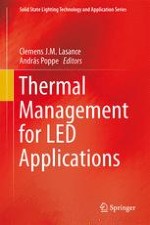2014 | OriginalPaper | Buchkapitel
11. Testing Issues in LED Manufacturing
verfasst von : Richard Young, PhD
Erschienen in: Thermal Management for LED Applications
Verlag: Springer New York
Aktivieren Sie unsere intelligente Suche, um passende Fachinhalte oder Patente zu finden.
Wählen Sie Textabschnitte aus um mit Künstlicher Intelligenz passenden Patente zu finden. powered by
Markieren Sie Textabschnitte, um KI-gestützt weitere passende Inhalte zu finden. powered by
